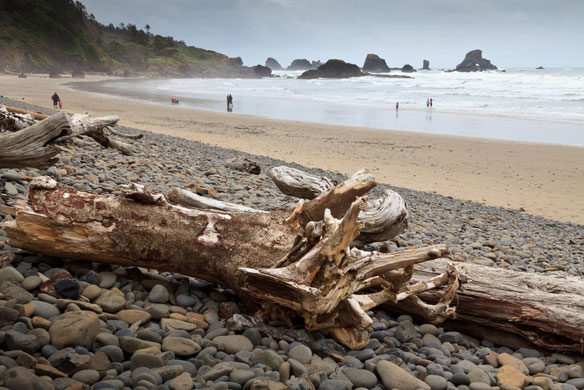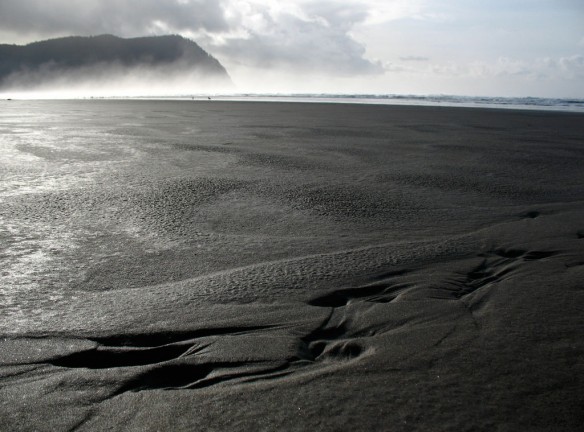
Indian beach, Oregon. Photo source: ©© N1DO
By USGS,
Executive summary
Beach erosion is a chronic problem along most open ocean shores of the United States. As coastal populations continue to increase and infrastructure is threatened by erosion, there is increased demand for accurate information regarding past and present trends and rates of shoreline movement. There is also a need for a comprehensive analysis of shoreline movement that is consistent from one coastal region to another. To meet these national needs, the U.S. Geological Survey (USGS) is conducting an analysis of historical shoreline changes along the open-ocean sandy shores of the conterminous United States and parts of Hawaii, Alaska, and the Great Lakes. One purpose of this work is to develop standard, repeatable methods for mapping and analyzing shoreline movement so that periodic, systematic, and internally consistent updates regarding coastal erosion and land loss can be made nationally. In the case of the analysis of shoreline change in the Pacific Northwest (PNW), the shoreline is the interpreted boundary between the ocean water surface and the sandy beach.
This report on the PNW coasts of Oregon and Washington is the seventh in a series of regionally focused reports on historical shoreline change. Previous investigations include analyses and descriptive reports of the U.S. Gulf of Mexico (Morton and others, 2004), the southeastern Atlantic (Morton and Miller, 2005), the sandy shorelines (Hapke and others, 2006) and coastal cliffs (Hapke and Reid, 2007) of California, the New England and mid-Atlantic coasts (Hapke and others, 2011), and parts of the Hawaii coast (Fletcher and others, 2012). Like the earlier reports in this series, this report summarizes the methods of analysis, interprets the results of the analysis, provides explanations regarding long- and short-term trends and rates of shoreline change, and describes how different coastal communities are responding to coastal erosion. This report differs from the early USGS reports in the series in that those shoreline change analyses incorporated only four total shorelines to represent specific time periods. This assessment of the PNW incorporates all available shorelines that meet minimum quality standards for resolution and positional accuracy. Shoreline change evaluations are based on a comparison of historical shoreline positions digitized from maps or aerial photographic data sources with recent shorelines, at least one of which is derived from lidar surveys. The historical shorelines cover a variety of time periods ranging from the 1800s through the 1980s, whereas the lidar shoreline is from 2002. Long-term rates of change are calculated using all available shoreline data and short-term rates of change are calculated using the lidar shoreline and the historical shoreline that will produce an assessment for a 15- to 35-year period. The rates of change presented in this report represent conditions up to the date of only the most recent shoreline data and therefore are not intended for predicting future shoreline positions or rates of change.
The PNW coast was subdivided into eight analysis regions for the purpose of graphically reporting regional trends in shoreline change rates. The average rate of long-term shoreline change for the entire PNW coast was 0.9 meter per year (m/yr) of progradation with an uncertainty of 0.07 m/yr. This rate is based on 8,823 individual transects, of which 36 percent was determined to be eroding. Long-term shoreline change was generally more progradational in Washington than in Oregon. This is primarily due to the influence of the Columbia River and human perturbations to the natural system, particularly the construction of jetties at both the mouth of the Columbia River and at Grays Harbor, Washington. The majority of the beaches in southwestern Washington have responded to these large-scale engineered structures by experiencing dramatic beach progradation during the past century. Although these beaches are still responding to the human effects, in several locations beaches that had been rapidly prograding are now either prograding at a slower rate or eroding.
The average rate of short-term shoreline change in the PNW was also progradational at a rate of 0.9 m/yr with an uncertainty of 0.03 m/yr. This rate is based on 9,087 individual transects, of which 44 percent was determined to be eroding. Similar to the results of the long-term shoreline change analysis, the shorelines in Washington were typically more progradational than those in Oregon in the short term. However, many stretches of coast in Oregon are either less accretional, changed from accretional to erosional, or more erosional when comparing the long- and short-term rate calculations. In the long and short term, there are significantly different historical shoreline change trends for beaches deriving their modern sediments from the Columbia River in southwestern Washington and northwestern Oregon, and beaches elsewhere in the PNW. The majority of shorelines in Oregon and in Washington’s Olympic Peninsula are not influenced by the human effects to the Columbia River littoral cell and typically have not experienced the human-induced century-scale trends apparent in southwestern Washington and northwestern Oregon.
An increase in erosion hazards in much of Oregon may be related to the effects of sea-level rise and increasing storm wave heights. Of importance, particularly in the short term, is the alongshore variability in land uplift rates due to tectonics, which results in an alongshore varying rate of relative sea level rise that appears to at least partially control the regional variability in short-term shoreline change rates. Other climate related processes, such as the occurrence of major El Niño events, also significantly affect the shoreline changes in the region. Major El Niño events elevate monthly mean sea levels by tens of centimeters throughout the winter and produce a shift in the storm tracks, resulting in alongshore redistributions in sand volumes on the beaches, leading to hotspot beach erosion and property losses north of headlands and tidal inlets to bays and estuaries. There are limited modern-day sources of sand to Oregon’s beaches, with much of the sand being relict in having arrived thousands of years ago at a time of lowered sea levels when headlands did not prevent the alongshore movement of the beach sediments, the result being that many beaches today are deficient in sand volumes and therefore do not provide sufficient buffer protection to backshore properties during winter storms.
Original Report: By Peter Ruggiero, Meredith G. Kratzmann, Emily A. Himmelstoss, David Reid, Jonathan Allan, and George Kaminsky
Coastal survey: Oregon beaches see more short-term erosion, Oregon State University
A new assessment of shoreline change along the Pacific Northwest coast from the late 1800s to present found that while the majority of beaches are stable or slightly accreting (adding sand), many Oregon beaches have experienced an increase in erosion hazards in recent decades. Since the 1960s, 13 of the 17 beach “littoral cells” – stretches of beach between rocky headlands and major inlets – in Oregon have shifted, either from a pattern of accretion to one of erosion, or to an increased amount of erosion, or they have built up less than in the past. Some of the hardest hit areas along the coast include the Neskowin littoral cell between Cascade Head and Pacific City, and the Beverly Beach littoral cell between Yaquina Head and Otter Rock, where shoreline change rates have averaged more than one meter of erosion a year since the 1960s…

Erosion on Seaside Beach, Oregon. Photo source: ©© Phil King








